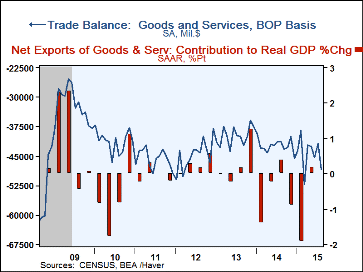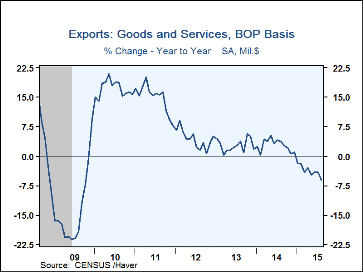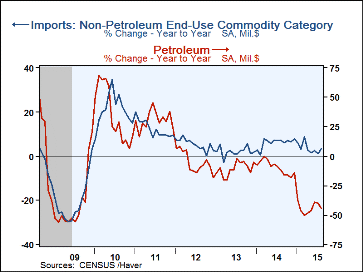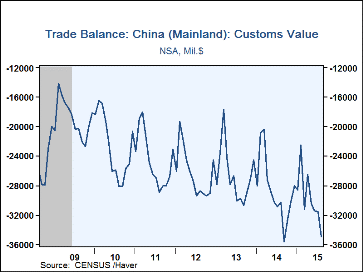 Global| Oct 06 2015
Global| Oct 06 2015U.S. Trade Deficit Deepens Unexpectedly
by:Tom Moeller
|in:Economy in Brief
Summary
These foreign trade figures add to the preliminary numbers released one week ago by including trade in services and data by country. The U.S. foreign trade deficit in goods and services during August increased to $48.3 billion from [...]
These foreign trade figures add to the preliminary numbers released one week ago by including trade in services and data by country.
The U.S. foreign trade deficit in goods and services during August increased to $48.3 billion from $41.8 billion in July, revised from $41.9 billion. A deficit of $43.0 billion had been expected in the Action Economics Forecast Survey. Exports declined 2.0% (-6.2% y/y) and imports rose 1.2% (-2.2% y/y). In constant dollars, the trade deficit in goods deepened to $63.4 billion from $56.1 billion. Real exports of goods fell 1.5% (-2.5% y/y) and reversed a 1.2% July surge while real goods imports increased 3.1% (6.8% y/y) after a 0.8% dip.
The 2.0% decline in exports reflected a 3.1% drop in goods, off 10.5% y/y. In constant dollars, goods exports fell 1.5% (-2.5% y/y) during August as auto exports declined 3.8% (-4.5% y/y) following a 5.0% gain. Nonauto consumer goods exports fell 3.0% (-4.0% y/y) and added to a 2.5% fall. Industrial supplies & materials exports were off 2.0% (-3.2% y/y), reversing a 2.5% increase. Capital goods exports gained 0.5% for a second straight month (-4.8% y/y). Foods, feeds & beverages exports also increased 0.5% (11.3% y/y) following two months of roughly 1.6% decline. Services exports improved 0.6% (2.5% y/y) as travel exports gained 0.8% (1.7% y/y).
Imports increased 1.2% during August (-2.2% y/y) and reversed a 1.0% decline during July. In constant dollars, nonpetroleum goods imports rose 3.5% (7.0% y/y) after a 1.0% drop. Nonauto consumer goods imports jumped 8.5% (14.2 % y/y) and reversed July's 4.9% decline. Capital goods imports increased 2.5% (1.4% y/y) following a 0.6% improvement. Foods, feeds & beverages imports gained 1.3% (4.2% y/y) after a 0.7% dip. Industrial supplies & materials imports eased 0.4% (+0.7% y/y) after a 1.4% jump and automotive vehicles & parts imports fell 1.0% (+10.3% y/y), offsetting a 1.3% increase. Imports of services improved 0.7% (3.7% y/y) as travel imports increased 1.5% (10.8% y/y).
Petroleum imports declined 11.7% in August (-44.7% y/y) after a 2.0% increase. In constant dollars, petroleum imports were off 1.7% (+1.9% y/y). The average per barrel cost of crude oil fell to $49.33 (-48.8% y/y). The value of energy-related petroleum product imports was off 15.7% (-45.4% y/y) as their quantity declined 6.8% (+3.0% y/y).
By country, the trade deficit in goods with China deepened to $35.0 billion, its deepest since September. Exports to China declined 4.7% y/y while imports from China jumped 10.5% y/y. The deficit with Japan eased to $5.2 billion. Exports to Japan declined 14.1% y/y and imports from Japan were off 4.5% y/y. The trade deficit with the European Union lessened m/m to $13.8 billion. Exports to the EU declined 10.0% y/y while imports from the EU rose 1.3% y/y.
The international trade data can be found in Haver's USECON database. Detailed figures are available in the USINT database. The expectations figures are from the Action Economics Forecast Survey, which is carried in the AS1REPNA.
Global Capital Flows from China from the Federal Reserve Bank of Kansas City is available here.
| Foreign Trade in Goods & Services (Current Dollars) | Aug | Jul | Jun | Y/Y | 2014 | 2013 | 2012 |
|---|---|---|---|---|---|---|---|
| U.S. Trade Deficit | $48.3 bil. | $41.8 bil. | $45.2 bil. | $41.3 bil. (8/14) |
$508.3 | $478.4 bil. | $536.8 bil. |
| Exports (% Chg) | -2.0 | 0.6 | -0.1 | -6.2 | 2.8 | 2.7 | 4.3 |
| Imports | 1.2 | -1.0 | 1.1 | -2.2 | 3.4 | 0.1 | 3.0 |
| Petroleum | -11.7 | 2.0 | 9.3 | -44.7 | -9.6 | -11.0 | -5.5 |
| Nonpetroleum | 3.1 | -1.3 | 0.5 | 3.4 | 6.1 | 2.0 | 5.2 |
Tom Moeller
AuthorMore in Author Profile »Prior to joining Haver Analytics in 2000, Mr. Moeller worked as the Economist at Chancellor Capital Management from 1985 to 1999. There, he developed comprehensive economic forecasts and interpreted economic data for equity and fixed income portfolio managers. Also at Chancellor, Mr. Moeller worked as an equity analyst and was responsible for researching and rating companies in the economically sensitive automobile and housing industries for investment in Chancellor’s equity portfolio. Prior to joining Chancellor, Mr. Moeller was an Economist at Citibank from 1979 to 1984. He also analyzed pricing behavior in the metals industry for the Council on Wage and Price Stability in Washington, D.C. In 1999, Mr. Moeller received the award for most accurate forecast from the Forecasters' Club of New York. From 1990 to 1992 he was President of the New York Association for Business Economists. Mr. Moeller earned an M.B.A. in Finance from Fordham University, where he graduated in 1987. He holds a Bachelor of Arts in Economics from George Washington University.










